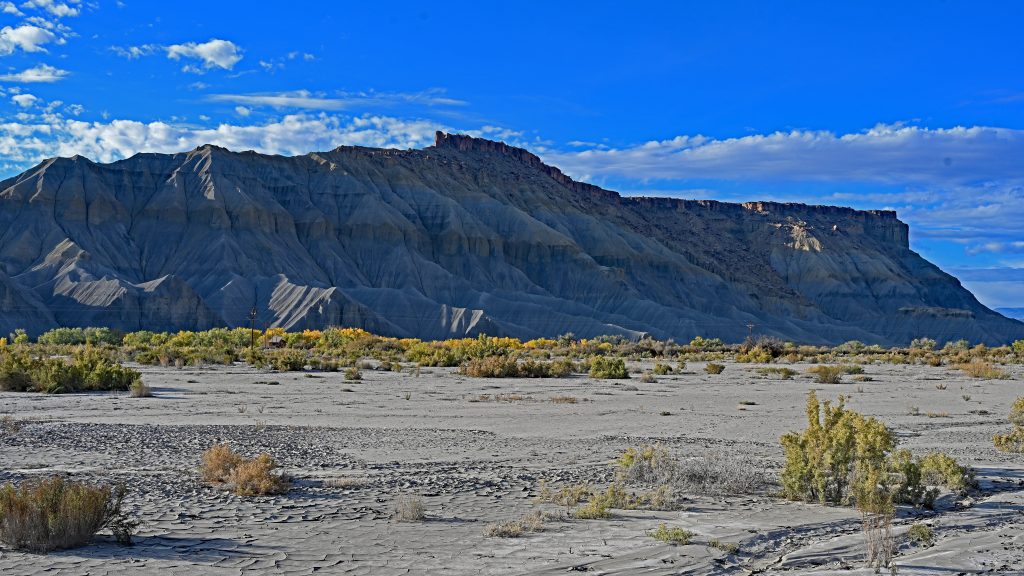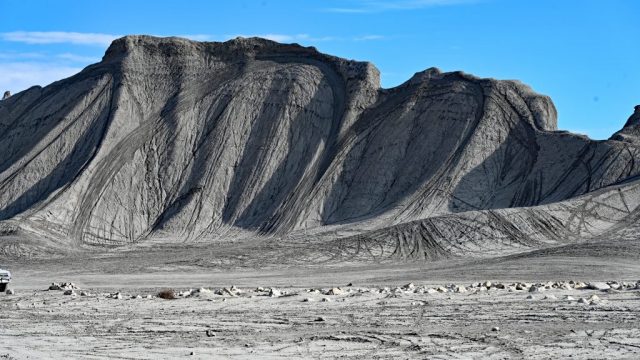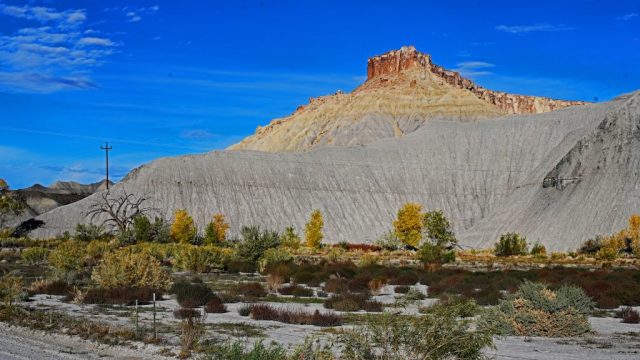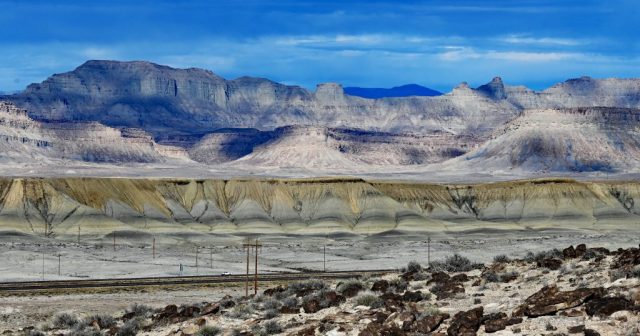October 22 2025
The morning sun greeted me with a brilliant blue sky, a vast promise of clear light and wide-open space. I had slept the night before out in the remote grandeur of the Cathedral Valley region — at a simple lodge opposite the iconic grey-toned mesas that punctuate so many of the famous photographs along Highway 24 in Utah.

View from the lodge – soft shadows across the grey ridges.
After breakfast, I set out eastward along Highway 24, intent on reaching the White Canyon via Highway 95. Almost immediately the landscape began to shift: the familiar red-rock cliffs gave way to more subtle, muted tones of grey rock formations that clustered especially around the Swing Arm City OHV Area — a place where the grey stone seemed to dominate, textured and sculpted.
Along this stretch, the rocks on the western flanks of the route rose in bold relief. Massive buttes and mesas took on ash-grey to bleached-silver hues — as though the usual rust-red pigment had been washed away over eons of exposure. At the same time, I noticed that above these grey masses, the rock layers were topped by streaks and caps of rich red and golden-shining stone. It created a dramatic layering: grey below, with more vivid warm tones crowning the ridges.
Why “the Grey”?
I did some research later to understand why this section of the scenic byway is sometimes referred to as the “grey” zone of this desert drive. Geological studies of the region around Capitol Reef National Park explain that the underlying rock units include formations of shale and siltstone that weather to bluish-grey slopes and gullies. Wikipedia+2sed.utah.edu+2
For example, the so-called Blue-Gate shale and other greyish marine deposits form the softer slopes beneath cliff-forming sandstones. visitutah.com+1
Hence the dominant appearance of broad grey hills and ridges in this stretch of Highway 24 — and why many descriptive travel guides highlight the effect of “cooler” colours (blues, greys, pale yellows) rather than the fiery reds one expects further west.
Back in my car, I stopped at several pull-outs, unable to resist photographing the sculpted forms: columns and ribbed slopes of grey sandstone, sometimes with bands of darker streaks where water had trickled in the past, or where mineral staining had taken effect. The contrast between the grey lower slopes and the red or golden caps was particularly striking in the afternoon light.
Then came an abrupt hitch in the day: about eight miles east of Hanksville I heard a hiss and felt the car sag — one of my tyres was flat. I pulled off carefully and inspected the wheel. I did have a spare and some tools to change it — but the jack was missing. So I stood by the road for a while, hoping for assistance. After ten minutes a vehicle emerged from the distance, the occupants asking if I needed help. They were a pair of pensioners who had been camping some two hundred yards down the road. Knowing I was staying at the motel in Cathedral Valley the night before, they had seen me and stopped by. Very kindly they offered to help, and together we managed to mount the spare tire — thin but serviceable. They advised me to drive on to Green River instead of continuing toward White Canyon, to find a proper tire replacement. Grateful, I accepted their advice — but first I stopped for a cappuccino in Hanksville, the warm foam a small comfort on a slightly stressful day.
From Hanksville to Green River
After the morning’s unexpected tire trouble near Hanksville, I continued my drive toward Green River. The spare was thin, and the miles ahead felt long, but the landscape more than made up for the tension. The highway wound gently through a vast, open desert where the grey hills slowly gave way to deeper, richer hues. On the western side, monumental ridges rose from the plain—layer upon layer of stone, carved by wind and time into canyons and towers. The light shifted constantly: one moment, the rock faces glowed pale silver; the next, shadows ran deep and blue between the folds. Higher up, the grey bases turned red and gold where sunlight caught the upper layers, as though the earth itself was burning softly beneath the sky. I stopped often, stepping out to take pictures and breathe in the silence. Each gust of wind carried dust and the faint scent of dry sage.
When I finally reached Green River, the day had warmed, and the little town shimmered like a mirage at the edge of the desert. A small mechanic’s workshop stood at the roadside. By pure luck, the owner had exactly one tire of the right size. He replaced it swiftly, and I felt as though the journey had smiled upon me again.
In the late afternoon I hiked a portion of the Athena Trail. The path was easy and gentle — exactly what I needed after the tension of the flat tire. As I walked, I looked out across the desert to the far horizons: to the north rose a low range of distant mountains, their crests faintly tinged with blue twilight; to the west, sharper ridges edged dark against the sky; to the east, mesas glowed in the waning light, their golden tops set above the pale grey slopes I had so admired earlier. Even though the mountains were far away, their presence grounded the landscape and gave it scale.
When I returned to the car, dusk was falling and the land took on a soft golden glow. I booked a hotel in Green River for the night, ready to rest well before tomorrow’s drive to Arches National Park — only eight miles before Moab. The day had been one of rugged scenery, unexpected kindness, and the quiet thrill of being alone on a long road through the wild.
Despite the flat tyre and the detour, I felt content. The grey cliffs, the red and golden crowns above them, and the wide-open desert sky had reminded me just why I travel: for those silent mountains, those strange slices of rock history, and the generosity of strangers along the way.
















